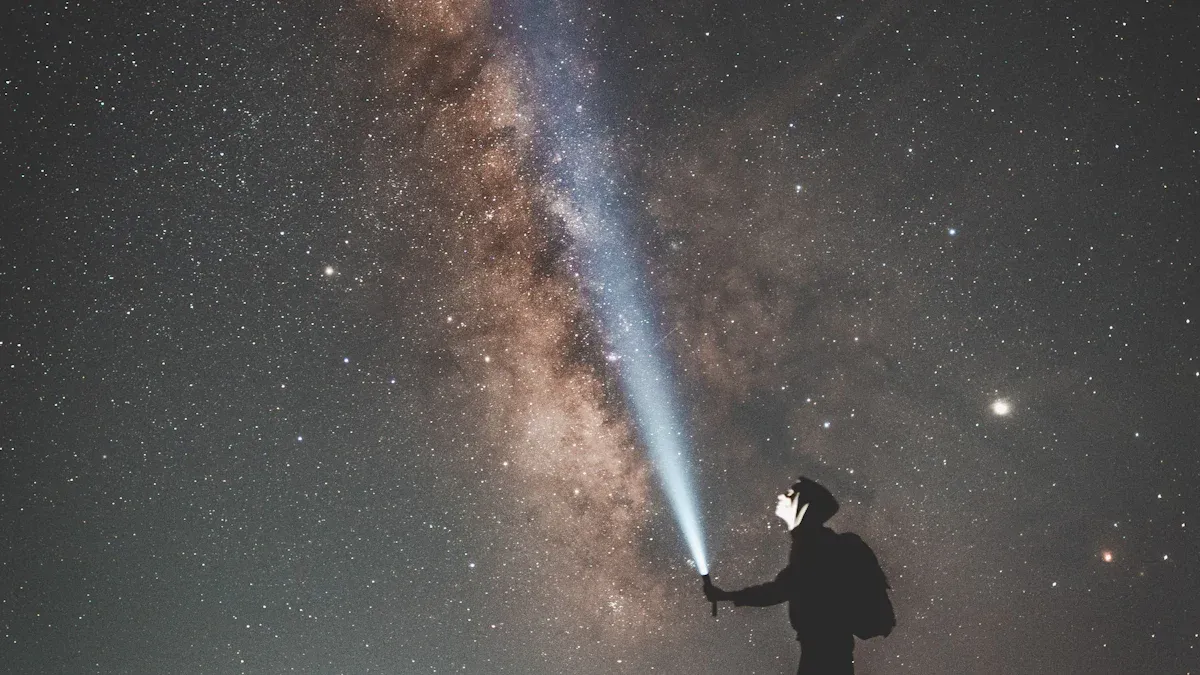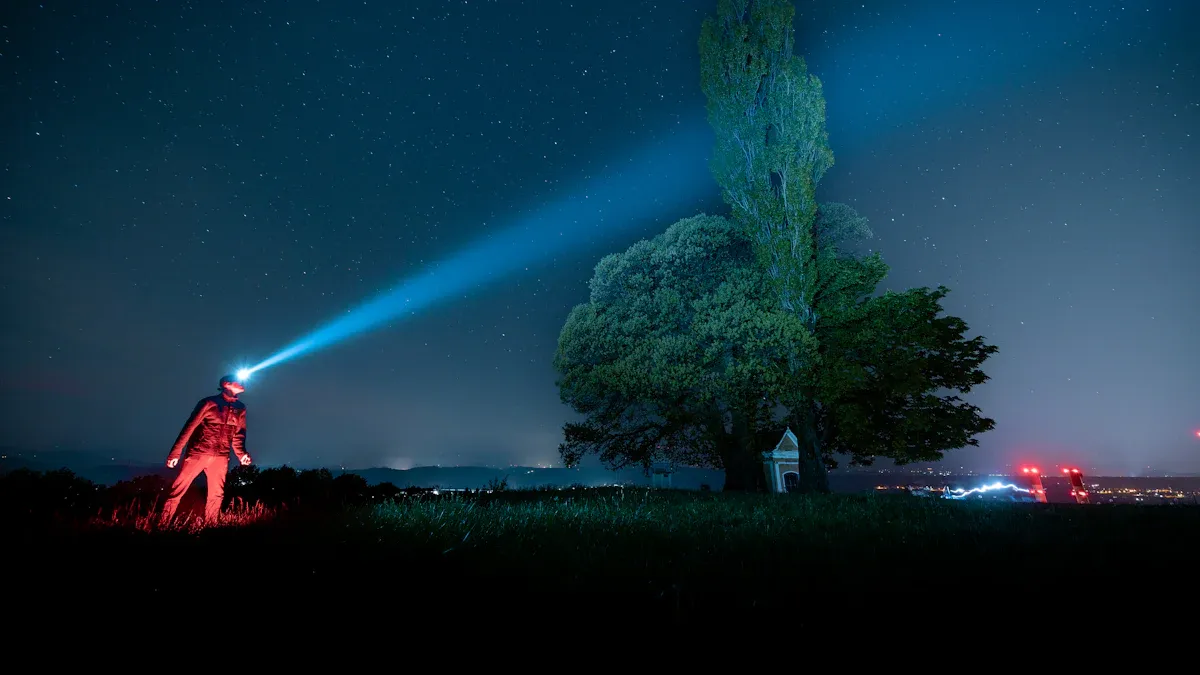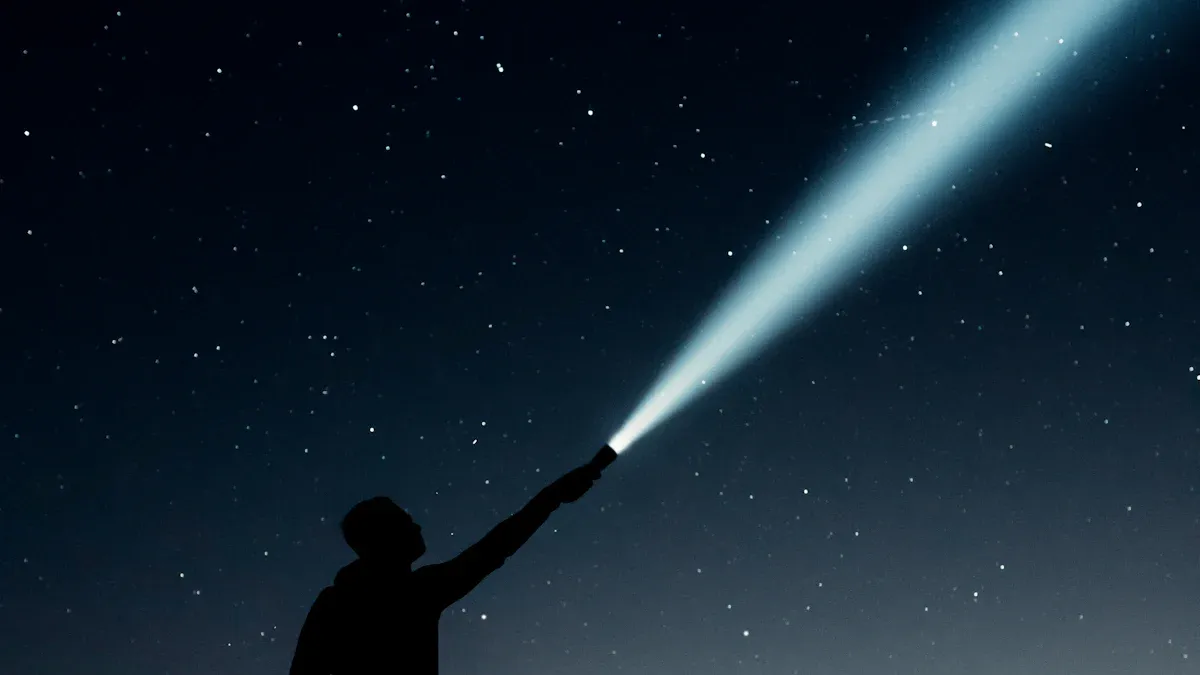Flashlights for Night Photography: Essential Gear for Stunning Outdoor Shots

Night photography demands preparation, and a flashlight is your essential tool. It ensures safety by illuminating uneven terrain and helps you set up equipment with precision. Flashlights also prevent blurry or grainy images by providing adequate lighting. Compact and portable, tools like the helius flashlight unlock creative techniques like light painting, enhancing your artistry.
Key Takeaways
Flashlights are important for staying safe in the dark. They help you walk on rough ground and avoid accidents when setting up your camera gear.
A flashlight improves night photography by giving enough light. It stops blurry photos and lets you try fun tricks like light painting.
Pick a flashlight with brightness and beam you can adjust. This helps you handle different situations and get the best light for your pictures.
Why Flashlights Are Essential for Night Photography
Ensuring safety and navigation in low-light conditions
When you venture into the outdoors for night photography, safety becomes a top priority. Low-light environments can hide uneven terrain, rocks, or other obstacles that might cause accidents. A flashlight helps you navigate these areas with confidence. It ensures you can see where you're stepping, even in unfamiliar locations. Without proper lighting, you risk injury or damaging your equipment. Flashlights for photography are not just tools; they are your safety companions in the dark.
Enhancing visibility for setting up equipment and framing shots
Setting up your photography gear in low-light conditions presents unique challenges:
Navigating in the dark becomes tricky, especially in new locations.
Bright lights can disrupt your ability to see the overall scene.
Your light source might interfere with other photographers' work, creating unwanted light trails.
Using flashlights for photography solves these problems. A flashlight with adjustable brightness allows you to illuminate your workspace without overpowering the scene. It helps you frame shots accurately and ensures your equipment is set up securely. This makes your night photography experience smoother and more enjoyable.
Using flashlights for creative techniques like light painting
Flashlights for photography unlock endless creative possibilities. Light painting is one of the most exciting techniques you can try. Here are some ideas:
Draw or write something with your flashlight to add a personal touch.
Place the light inside an object to make it glow.
Combine light painting with portraiture for surreal effects.
Use reflective surfaces to capture dramatic light patterns.
Enhance landscapes with otherworldly vibes by painting light across the scene.
These techniques allow you to transform ordinary photos into stunning works of art. A flashlight becomes more than a tool—it becomes your brush for painting with light.
Key Features to Look for in a Flashlight
Brightness and lumens for optimal lighting
When choosing a flashlight for night photography, brightness plays a crucial role. The brightness of a flashlight is measured in lumens, and selecting the right level depends on your needs. For night photography, a flashlight with 500 to 1000 lumens works well for activities like hiking or setting up long exposure shots. If you plan to explore more intense outdoor environments, consider a flashlight with over 1000 lumens. The table below provides a quick guide to brightness levels and their applications:
Brightness Level (Lumens) | Application |
|---|---|
Less than 150 | Night light, reading light, backlighting |
150 - 500 | Everyday tasks indoors and outdoors, DIY |
500 - 1000 | Camping, fishing, walking, hiking at night |
1000 - 3000 | Outdoor activities |
Over 3000 | Hunting, Police, Search & Rescue |
A flashlight with adjustable brightness settings allows you to adapt to different scenarios, whether you're framing a shot or experimenting with long exposures.
Beam adjustability for focused or wide lighting
Beam adjustability enhances your control over lighting. A focused beam helps you highlight specific areas, such as a subject in the foreground. On the other hand, a wide beam spreads light across a larger area, making it ideal for illuminating landscapes during long exposure photography. Look for flashlights with zoomable or adjustable beams to switch between these modes effortlessly. This feature ensures you can adapt your lighting to suit the creative demands of your night photography.
Battery life and power options for extended use
Long exposure photography often requires extended periods of shooting. A flashlight with reliable battery life ensures you won't run out of light during critical moments. Rechargeable batteries offer convenience and cost savings, while replaceable batteries provide flexibility in remote locations. Some flashlights also feature power indicators, so you can monitor battery levels and plan accordingly. Always carry spare batteries or a portable charger to avoid interruptions during your photography sessions.
Durability and weather resistance for outdoor conditions
Outdoor photography exposes your flashlight to challenging conditions. A durable flashlight withstands rough handling and harsh environments. Look for models made from high-quality materials that resist corrosion and wear. Waterproof ratings, rubber seals, and gaskets protect against water ingress, ensuring your flashlight performs well in rain or damp conditions. Manufacturers often test flashlights rigorously to ensure reliability in real-world scenarios. These features make your flashlight a dependable companion for capturing stunning long exposures in any weather.
Types of Flashlights for Night Photography

Handheld flashlights for versatile use
Handheld flashlights are a favorite among photographers for their precision and flexibility. They allow you to control exactly where the light falls, making it easier to highlight specific areas of your scene. You can walk around your subject, experiment with different angles, and even use the flashlight for creative light painting. This technique helps you illuminate important details that might otherwise remain hidden in the shadows. Compared to electronic flashes, handheld flashlights produce softer light, which reduces harsh shadows and reflections. Their portability and ease of use make them an essential tool for night photography.
Headlamps for hands-free operation
Headlamps are perfect for photographers who need both hands free to handle their gear. These lightweight tools provide hands-free lighting, allowing you to stabilize your camera or adjust settings without juggling a flashlight. You can easily adjust the beam to focus on specific areas, giving you more control over your lighting. Headlamps also enhance mobility, letting you move freely while carrying your equipment. Their versatility makes them ideal for various environments, whether you're shooting in a dense forest or an open field.
LED flashlights for energy efficiency and brightness
LED flashlights for photography combine brightness with energy efficiency. They deliver high lumen output, ensuring your scene is well-lit even in the darkest conditions. These flashlights consume significantly less energy than traditional bulbs, which extends battery life and reduces the need for frequent recharging. Their compact size makes them easy to pack, and many models can attach to tripods for added convenience. LED flashlights for photography are a reliable choice for outdoor shoots, offering both portability and performance.
Top Flashlight Recommendations
Coast G9 Flashlight: Compact, versatile, and ideal for night photography
The Coast G9 flashlight stands out as a reliable tool for night photography. Its ability to produce a soft, dim light makes it perfect for capturing delicate details without overpowering your scene. You can also use color-correcting gels with this flashlight to adjust the light's color temperature. This feature allows you to create unique effects and match the lighting to your artistic vision. Its compact size ensures it fits easily into your gear bag, making it a convenient choice for outdoor shoots. Whether you're setting up your helius flashlight or experimenting with creative techniques, the Coast G9 offers the versatility you need.
JetBeam Flashlight: Adjustable brightness levels for various lighting needs
The JetBeam Flashlight provides unmatched flexibility with its adjustable brightness settings. You can tailor the light output to suit different photography scenarios, from illuminating a wide landscape to focusing on a specific subject. This level of customization ensures you achieve the perfect lighting conditions for your shots. Its ergonomic design makes it easy to handle, even during extended sessions. Pairing the JetBeam with your helius flashlight can enhance your setup, giving you more control over your lighting and helping you capture stunning images in any environment.
ThruNite Archer 2A C: Ergonomic design and excellent illumination for outdoor use
The ThruNite Archer 2A C combines comfort and performance, making it a favorite among outdoor photographers. Its ergonomic design ensures a secure grip, while its powerful illumination brightens even the darkest scenes. This flashlight is built to withstand tough outdoor conditions, ensuring reliability during your night photography adventures. When used alongside your helius flashlight, the ThruNite Archer 2A C adds depth and dimension to your lighting setup. Its durability and efficiency make it a valuable addition to your gear collection.
Creative Uses of Flashlights in Night Photography

Light painting techniques for artistic effects
Light painting offers endless opportunities to create unique and artistic photographs. You can use a flashlight to draw shapes, write words, or highlight specific areas in your scene. For example, you might trace the outline of a tree or create glowing patterns in the air. This technique works well during long exposure photography, where the camera captures the movement of light over time. Experiment with different colors by placing gels over your flashlight. This adds a vibrant and surreal quality to your images. Light painting allows you to transform ordinary scenes into extraordinary works of art.
Creating soft light for balanced exposure
Flashlights can help you achieve balanced exposure by softening harsh shadows and brightening darker areas. Follow these steps to create soft light:
Use the flashlight to illuminate darker areas during long exposures.
Paint light onto your subject to emphasize important details.
Adjust the light intensity to match the scene's needs.
For even softer light, try indirect lighting techniques:
Shine the flashlight onto a white wall to reflect light onto your subject.
Attach a diffuser to the flashlight to spread the light evenly.
Switch to flood mode for a broader, gentler light source.
These methods ensure your photos have a natural and well-balanced look.
Adding depth and dimension to outdoor scenes
Flashlights can add depth and texture to your outdoor shots. Use a remote trigger to control the light source and move the flashlight off-camera for more natural lighting. Experiment with the direction and intensity of the light to highlight textures in the foreground or create dramatic shadows. Light painting can also enhance your scene by adding warmth and detail to dark areas. For example, you might sweep the flashlight across a rocky surface to bring out its texture. These techniques help you create dynamic and visually engaging photographs.
Tips for Using Flashlights Effectively
Positioning the flashlight to avoid harsh shadows
The way you position your flashlight can make or break your shot. Direct light often creates harsh shadows that distract from your subject. To avoid this, try angling the flashlight slightly to the side instead of pointing it straight at the subject. This technique softens the shadows and adds depth to your image.
Tip: Use a diffuser or bounce the light off a reflective surface like a white card or wall. This spreads the light evenly and reduces harshness.
Experiment with different positions to see how the light interacts with your subject. Moving the flashlight closer or farther away can also change the intensity and shadow placement.
Adjusting brightness to match the scene
Brightness control is crucial for achieving the right exposure. A flashlight that’s too bright can wash out details, while one that’s too dim may leave parts of the scene underexposed. Adjust the brightness to complement the natural light in your environment.
Use lower brightness for close-up shots to avoid overexposure.
Increase brightness for larger scenes or when highlighting distant objects.
Some flashlights come with adjustable brightness settings. These allow you to fine-tune the light output for different scenarios. Always test the brightness before taking the shot to ensure it matches your creative vision.
Combining flashlight use with other light sources
Flashlights work best when paired with other light sources. Combining them with ambient light, moonlight, or even artificial lights can create stunning effects. For example, you can use the flashlight to highlight a specific subject while letting the ambient light fill the background.
Pro Tip: Use gels or filters on your flashlight to match the color temperature of other light sources. This creates a cohesive and balanced look.
Layering light sources adds complexity to your photos. It helps you achieve a professional and polished result. Experiment with different combinations to discover what works best for your scene.
Flashlights play a vital role in night photography by ensuring safety and unlocking creative possibilities. They provide adequate lighting for sharp, colorful images and enable techniques like light painting. Their portability and flexibility make them indispensable for outdoor shoots.
Key benefits of flashlights:
Illuminate dark areas for better visibility.
Enable creative effects like light trails.
Offer a lightweight, portable alternative to studio lights.
Investing in a high-quality flashlight, such as the Helius Flashlight, enhances your photography experience.
Feature | Benefit |
|---|---|
Lightweight design | Ensures ease of use during outdoor activities |
Powerful LED light source | Provides excellent illumination |
Zoomable function | Allows for adjustable focus |
Multiple lighting modes | Enhances versatility |
Type-C fast charging | Improves convenience |
LED power display | Aids in battery management |
Waterproof rating | Ensures reliability in various conditions |
Exploring flashlight techniques can elevate your creativity. Use them to illuminate dark subjects, experiment with light painting, and capture unique images. Stepping out of your comfort zone and practicing patience will help you master night photography. Embrace the adventure and let your flashlight guide you to stunning results!
FAQ
What flashlight brightness is ideal for night photography?
A flashlight with 500 to 1000 lumens works well for most night photography scenarios. It provides sufficient light for setting up gear and creative techniques.
Can you use a flashlight for astrophotography?
Yes, a flashlight helps illuminate foreground elements while photographing the night sky. Use it sparingly to avoid overpowering the stars or star trails.
Why is a tripod essential for night photography?
A tripod stabilizes your camera for long exposures. It ensures sharp shots and helps you capture stars, star trails, and other low-light scenes effectively.
See Also
Why Hunting Flashlights Are Crucial For Outdoor Adventures
SF1 Camping Flashlight: Brighten Up Your Outdoor Experiences
Your Complete Guide To Selecting The Best Hiking Flashlight
A Detailed Guide To Selecting The Perfect Home Flashlight
Key Tools: Effective Headlamps For Hands-Free Lighting Solutions
